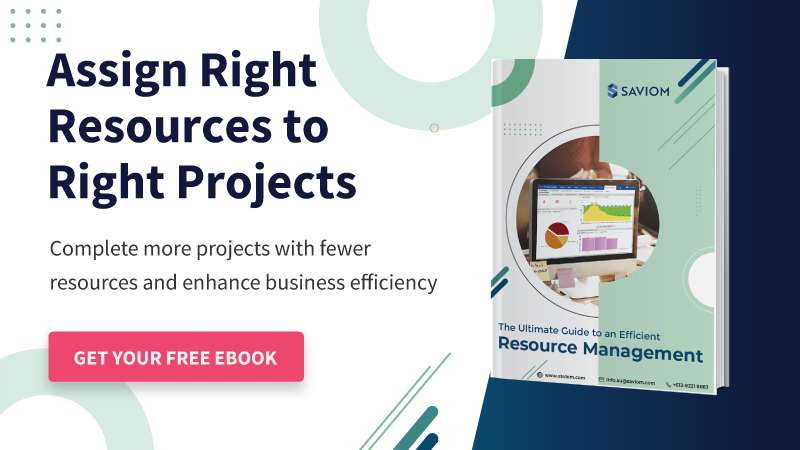Over the years, the business landscape has witnessed a radical shift from traditional hierarchical structures to matrix organizations primarily for enhancing interdepartmental collaboration and workforce efficiency. Moreover, the advent of globalization and remote working has enabled firms to hire across geographical boundaries.
While all these advancements have facilitated business to maintain a competitive edge, it has brought forward multiple resourcing bottlenecks. Some of them are suboptimal resource utilization, lowered productivity, frequent hiring/firing, skills shortage, etc. These challenges can jeopardize business profitability and sustainability if not resolved in time.
Thus, firms need to implement a tool that provides real-time insights into necessary resource metrics and help them make informed decisions. This is where a modern resource management solution equipped with Business Intelligence comes into the picture. This blog emphasizes the benefits of using business intelligence in resource management. But before that, let’s get started with the basics. 
What is business intelligence and its importance in resource management?
Business intelligence (BI) is a tool that analyzes data and delivers actionable insights in a structured manner to help organizations make informed business decisions. It combines data analytics, data mining, data visualization, data tools, and infrastructure to present meaningful information in the form of dashboards, reports, etc. Upper management, stakeholders, and managers can leverage these reports to minimize inefficiencies, drive change, and more. Over the years, resource management has become very complex as it is no longer restricted to basic scheduling using excelsheets. To manage resources efficiently amid the growing market uncertainties, organizations need real-time data along with past data for quick and informed decision-making. That’s why the Business Intelligence interface has become an integral component of resource management software. Let’s understand its’ components.
Essential components of BI
Business Intelligence is a complex tool and entails multiple components. The following section enlists the most important ones:
Big data
Big data refers to the combination of structured, semi-structured, and unstructured data. It is defined by the three Vs- data with greater Variety, arriving in large Volumes, and with more Velocity. Subject to its volume and complexity, this data can only be analyzed and structured using advanced machine learning and predictive analytics. Additionally, it is extracted from multiple sources such as websites, surveys, etc.
Data warehousing
A data warehouse is a data management system that supports Business Intelligence activities, especially analytics. It contains a large amount of historical data and further runs queries and analysis to extract information. Data warehousing is the process of constructing and using a data warehouse to clean, structure, and consolidate data from multiple heterogeneous sources. The goal of data warehousing is to create a trove of historical data that can be retrieved and analyzed by businesses to improve CRM, product strategies, etc.
OLAP (Online Analytical Processing)
The OLAP is a technology that runs a multidimensional analysis of information from the data cubes (prepared during data warehousing) at a very high speed. Businesses can view information from multiple angles, slice/dice data, etc., and make informed decisions. In addition, budgeting, forecasting, reporting, etc., are done using OLAP.
Reporting interface
Reporting interface in business intelligence denotes the presentation of data to the end-users in a comprehensible manner. Usually, a report is presented in the form of graphs, tables, charts, etc. Also, it can be exported in other forms, such as excel, pdf, etc., to ensure versatile use. Thus, it helps stakeholders understand large sets of data from simple graphs and dashboards within a short duration.
Administrative interface
The administrative interface, as the name suggests, provides server control to the admin. They are responsible for customizing the dashboards as per specific business requirements. Additionally, the administrative interface offers secured role-based access to the users to prevent data breach and information overload. Now that we have read about the essential components of BI let’s look at how it has evolved in the past years. 
An overview of the evolution of BI
The evolution of BI can be traced back to Richard Millar Devens’s time, in his book “ Cyclopaedia of Commercial and Business Anecdotes.” In this book, he has explained how a banker beat his competitors by collecting data about recent market trends and altering his strategy. However, the term ‘Business Intelligence’ was only coined later by computer scientist Hans Peter Luhn. Earlier, data from multiple sources were stored in silos, and only a few people with strong analytical skills could collate and translate it into meaningful reports. Around the 1980s, big data came into the picture, and it was stored in data warehouses in an organized manner. However, businesses were unaware of how to use this new technology; thus, it became more cumbersome for them. This challenge was solved in the 1990s when BI 1.0 surfaced, and this period was called the era of BI. Even then, since new technology was a hefty investment, not every business could afford it. Finally, in 2000, real-time data was developed, and managers started leveraging it to make quick decisions. Later on, they were also able to configure the dashboards and reports according to their needs. In 2017, significant advances in BI technology were made that included seamless integration of multiple tools to avoid double data entries and redundancies. As per a study, the Global BI and analytics market is expected to grow to $26 billion by end of 2022 As the business intelligence landscape is constantly evolving, organizations are adapting to it to reach their goals since it provides at-a-glance analysis for decision-making or planning. Owing to these benefits, the BI tool is now integrated into resource management software. The following section explains its benefits in this realm.
Benefits of BI in resource management
Using Business intelligence in resource management offers myriads of benefits to organizations. Here are the most prominent ones-
Promotes data-driven decision-making with real-time insights
With BI-enabled resource management software, managers can get real-time insights into multiple resource metrics such as utilization, availability, capacity vs. demand, etc. They can use the information to implement course-corrective measures ahead of time. For instance, the forecast vs. actual utilization report helps managers understand the actual time taken to accomplish a task against the planned estimates. In case there is a deviation, managers can connect with the employees, understand the reason, and course-correct accordingly.
Read More: How Can You Make Data-Driven Decisions with Resource Management Software?
Provides customized dashboards and reports
The BI Dashboards are typically the product of reporting interface. After the big data goes through data warehousing and OLAP, the insights are represented in the form of graphs, reports, etc. Thus, using that, the resource managers can create or configure the dashboards as per their requirements and view the data. For instance, a resource manager can view the billable, non-billable, and strategic utilization in one graph and understand the resource’s work distribution. Similarly, a project manager can configure the team’s utilization report for their respective projects. Furthermore, the dashboards are built with administrative interfaces that give role-based access and prevent information overload.
Helps prevent resourcing bottlenecks with accurate analytics
When managers create a resource plan based on mere guesswork and intuition, it can lead to certain bottlenecks such as last-minute firefighting, skills shortage, over/under utilization of the workforce, etc. Business Intelligence and its powerful analytics help managers combat these bottlenecks and ensure the project’s success. For example, – When a project manager sends resource requests, it immediately reflects in the project vacancy and demand report. Thus, the resource manager can foresee the resource demand and implement appropriate resourcing measures to fulfill them and avoid last-minute firefighting. Furthermore, resource managers can also procure people on the bench reports that will help them re-train the resources for future projects and minimize bench size.
Read More: 9 Effective Ways to Manage Capacity Planning Bottlenecks
Futureproof the workforce with actionable insights
The resource management software uses OLAP technology of the BI tool for accurate forecasting. So, using this advanced forecasting, managers get foresight into pipeline project demands in terms of skillset, competencies, efforts, location, etc. Based on that, they can evaluate existing resource capacity against the project demands. If there is a gap, they can initiate upskilling and re-training programs and L&D initiatives to future-proof the workforce and bridge the capacity vs. demand gap. Also, the BI tool updates the competency matrix regularly, which helps managers formulate an ideal Individual development plan (IDP) for each employee.
Facilitates maintaining a healthy resource index
The lack of accurate insights into resource metrics can lead to double-booking or sub-optimal workforce utilization. The over-allocation of resources will lead to stress and burnout, which can even cause unplanned attrition. On the contrary, underutilization of resources will result in disengagement, leading to a demotivated workforce. But, with the help of business intelligence analytics, managers can get accurate updates with the utilization heatmap. It provides them with a comprehensive view of the resources’ utilization rates in a color-coded manner by which they can determine if a resource is over/underutilized. As a result, they can take remedial measures to improve productivity and optimize the resource health index. For example- If a resource is over-utilized, then managers can procure additional resources and adjust the project timelines.
Read More: What is Resource Utilization and its Significance?
The bottom line
“BI is about providing the right data at the right time to the right people so that they can take the right decisions” – Nic Smith with Microsoft BI Solutions Marketing Rightly said, BI is built to improve and strengthen data-driven decision-making. It provides organizations with the ability to access information critical to their success across a multitude of fields and departments, thereby giving them a competitive edge in the market. So, has your organization started using Business Intelligence-enabled Resource Management yet?
The Glossary
Read More: Glossary of Resource Workforce Planning, Scheduling and Management
The SAVIOM Solution
SAVIOM is the market leader in offering the most powerful and configurable solutions for managing enterprise resources efficiently and effectively. Having more than 20 years of experience, this Australian-based MNC has a global presence in over 50 countries. It is also popular with more than 100 customers and helps them achieve their business goals. SAVIOM also has products for project portfolio management, professional service automation, and workforce planning software which can be easily customized as per business requirements.







